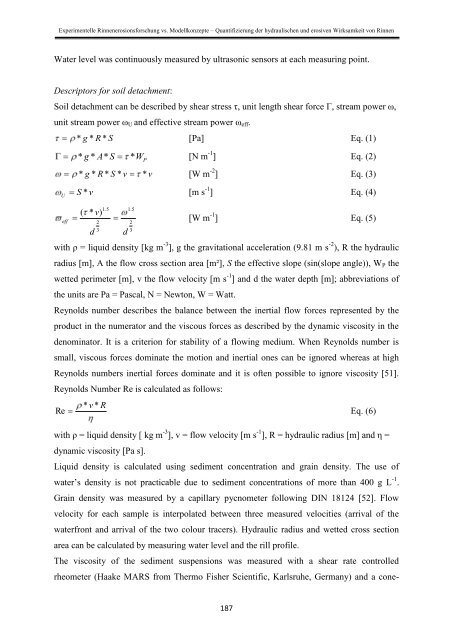Stefan Wirtz Vom Fachbereich VI (Geographie/Geowissenschaften ...
Stefan Wirtz Vom Fachbereich VI (Geographie/Geowissenschaften ...
Stefan Wirtz Vom Fachbereich VI (Geographie/Geowissenschaften ...
Create successful ePaper yourself
Turn your PDF publications into a flip-book with our unique Google optimized e-Paper software.
Experimentelle Rinnenerosionsforschung vs. Modellkonzepte – Quantifizierung der hydraulischen und erosiven Wirksamkeit von Rinnen<br />
Water level was continuously measured by ultrasonic sensors at each measuring point.<br />
Descriptors for soil detachment:<br />
Soil detachment can be described by shear stress τ, unit length shear force Γ, stream power ω,<br />
unit stream power ω U and effective stream power ω eff .<br />
* g * R * S<br />
[Pa] Eq. (1)<br />
* g * A*<br />
S *<br />
[N m -1 ] Eq. (2)<br />
W P<br />
* g * R * S * v * v [W m -2 ] Eq. (3)<br />
U<br />
S * v<br />
[m s -1 ] Eq. (4)<br />
1.5 1.5<br />
( * v)<br />
eff<br />
[W m -1 ] Eq. (5)<br />
2<br />
2<br />
3<br />
3<br />
d d<br />
with ρ = liquid density [kg m -3 ], g the gravitational acceleration (9.81 m s -2 ), R the hydraulic<br />
radius [m], A the flow cross section area [m²], S the effective slope (sin(slope angle)), W P the<br />
wetted perimeter [m], v the flow velocity [m s -1 ] and d the water depth [m]; abbreviations of<br />
the units are Pa = Pascal, N = Newton, W = Watt.<br />
Reynolds number describes the balance between the inertial flow forces represented by the<br />
product in the numerator and the viscous forces as described by the dynamic viscosity in the<br />
denominator. It is a criterion for stability of a flowing medium. When Reynolds number is<br />
small, viscous forces dominate the motion and inertial ones can be ignored whereas at high<br />
Reynolds numbers inertial forces dominate and it is often possible to ignore viscosity [51].<br />
Reynolds Number Re is calculated as follows:<br />
*v * R<br />
Re Eq. (6)<br />
with ρ = liquid density [ kg m -3 ], v = flow velocity [m s -1 ], R = hydraulic radius [m] and η =<br />
dynamic viscosity [Pa s].<br />
Liquid density is calculated using sediment concentration and grain density. The use of<br />
water’s density is not practicable due to sediment concentrations of more than 400 g L -1 .<br />
Grain density was measured by a capillary pycnometer following DIN 18124 [52]. Flow<br />
velocity for each sample is interpolated between three measured velocities (arrival of the<br />
waterfront and arrival of the two colour tracers). Hydraulic radius and wetted cross section<br />
area can be calculated by measuring water level and the rill profile.<br />
The viscosity of the sediment suspensions was measured with a shear rate controlled<br />
rheometer (Haake MARS from Thermo Fisher Scientific, Karlsruhe, Germany) and a cone-<br />
187
















